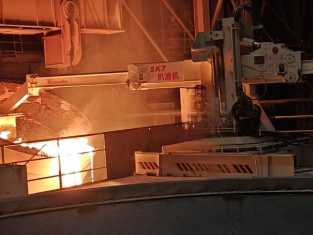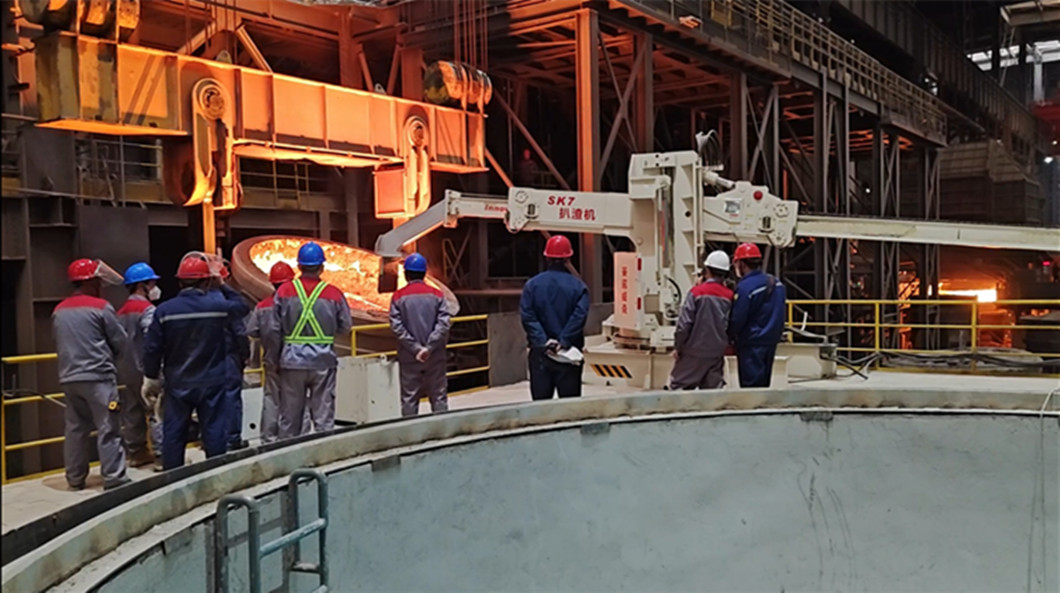In the metallurgical industry, the efficient removal of slag—molten byproducts formed during metal smelting—directly determines product quality, process stability, and operational safety. As a core piece of equipment for slag treatment, the slag raking machine has evolved into a multi-functional, high-efficiency solution tailored to diverse high-temperature working environments. This article explores its structural composition, operational mechanisms, application scenarios, and technological advancements.

Skimming floating slag from ladles, electric arc furnaces, and refining furnaces;
Manipulating scrap materials during melting to accelerate metallurgical reactions;
Transporting collected slag to designated disposal areas (e.g., slag buckets);
Reducing metallurgical load by minimizing slag contamination in molten metal .
Raking Arm Assembly: The core working part, featuring adjustable tines (rake-like teeth) for digging into slag crusts. Advanced models adopt dual-raking configurations that fold/unfold synchronously .
Slewing and Lifting Mechanisms: Enable horizontal rotation (left/right), vertical lifting, and forward/reverse movement of the raking arm, with a large bearing base ensuring stable slew motion .
Mounting Systems: Customized based on workshop layouts—options include fixed pedestals, mobile crawlers, or articulating arm suspensions .
Material Selection: High-strength mild steel or heat-resistant carbon steel for durability under temperatures exceeding 1,500°C .
Hydraulic Drive: Powers arm movements with pumps, cylinders, and valves—delivering precise control and high load-bearing capacity . Cooling and filtration systems prevent oil overheating and contamination.
Electrical Control: Automated grade systems with sensors monitor pressure, position, and temperature, enabling cyclic operation without manual intervention .
Conveyor systems (chain-driven for longevity) transport slag directly to disposal points ;
Lubrication systems reduce wear on moving parts, extending service life ;
Safety devices (e.g., thermal shields, emergency stop buttons) mitigate operational risks.
Positioning: The raking arm is maneuvered vertically to align with the slag layer and horizontally to reach the target area (e.g., ladle mouth).
Slag Engagement: Hydraulic cylinders extend the arm, driving the tines into the slag crust—leveraging mechanical advantage to break up solidified slag .
Skimming and Collection: The arm retracts while rotating, skimming slag from the molten metal surface. Dual-raking models 收拢 (fold) to clamp slag securely .
Transport and Dumping: The arm lifts and slews to the disposal site (e.g., a slag bucket), then unfolds to release collected material.
Reset: The arm returns to its parked position, completing one operational cycle .
For narrow spaces (e.g., underground tunnels), crawler-mounted machines with compact designs enable full-section loading without dead corners.

Ladle Treatment: Removing slag from hot metal ladles post-desulfurization (e.g., KR desulfurization processes) ;
Furnace Operations: Skimming electric arc furnaces (EAF) and ladle refining furnaces (LRF) during steelmaking .
Reduces front-end weight, improving maneuverability;
Shields drives from high temperatures, lowering failure rates;
Combines the advantages of traditional machines (high early-stage slag removal efficiency, <1.5 kg iron loss per ton) with rapid late-stage cleaning .
Next-generation models integrate IoT sensors for real-time monitoring of hydraulic pressure, arm position, and slag levels—enabling predictive maintenance and remote operation. This reduces downtime and labor costs.
